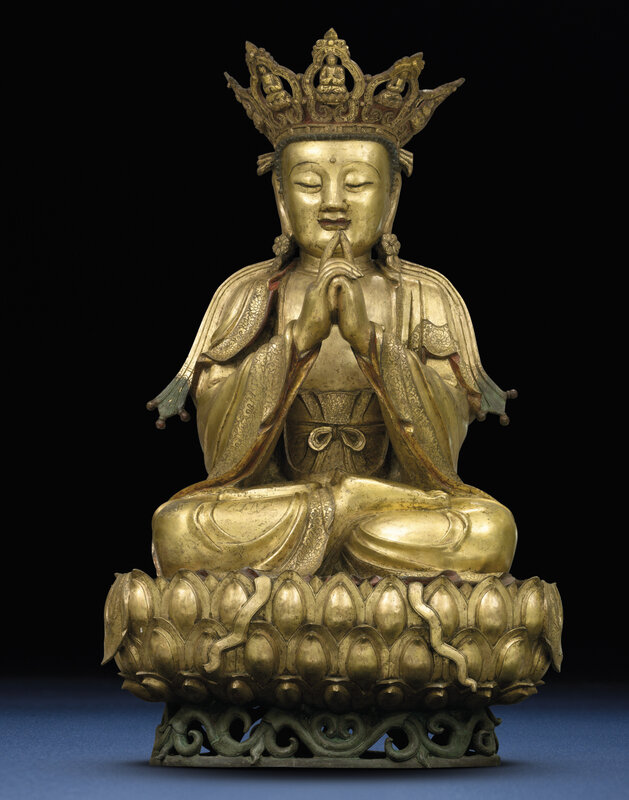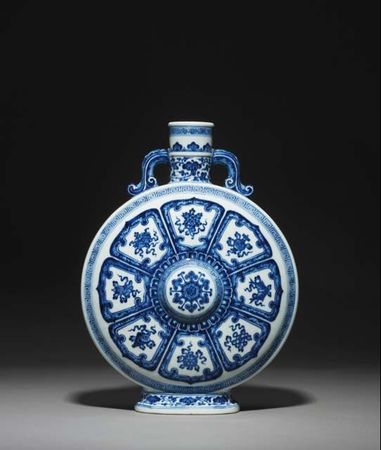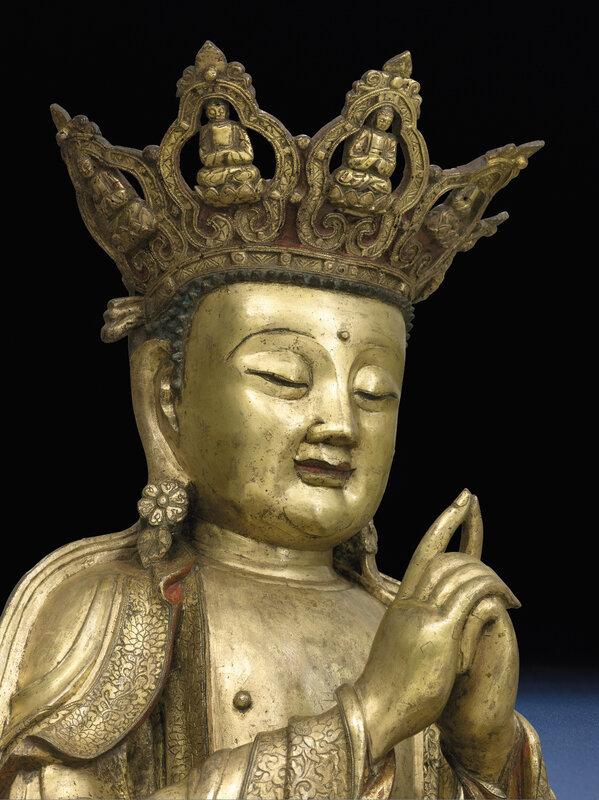Christie's presents superb and rare Chinese ceramics and works of art in New York this September
Lot 3770. A very rare large finely cast gilt-bronze figure of Vairocana, Ming dynasty, 16th Century; 20 ¼ inches (51.5 cm.) high. Estimate: HKD 10,000,000 - HKD 15,000,000 ($600,000-800,000). Price realised HKD 11,860,000 © Christie's Images Ltd 2011.
NEW YORK, NY.- On September 15 and 16, Christie's New York will present Fine Chinese Ceramics and Works of Art, which all together offers over 550 objects across many categories and tastes, and many from private collections. Highlighting the sale is a very rare large and finely cast gilt-bronze figure of Vairocana (estimate: $600,000-800,000), which is an exceptional example of its type, exhibiting superb casting and fine attention to detail. With estimates ranging from $4,000 to $1 million, the sale is expected to realize in the region of $19 million.
One of the highlights of the ceramics section is a rare blue and white Ming-style moonflask, Qianlong seal mark in underglaze blue and of the period (1736-1795) (estimate: $500,000-700,000).
This flask is particularly rare as other examples of this design are usually of larger size.
A rare blue and white moonflask, Bianping Yongle Period (1403-1425). 10in. (26.7 cm.) high, wood stand, box. Estimate: $60,000-80,000. Photo: Chrisie's Images Ltd 2011
The sale also includes a group of fine doucai porcelains including a rare doucai dish, Kangxi six-character mark in underglaze blue within a double circle and of the period (1662-1722) (estimate: $200,000-300,000); and a very rare doucai meiping, Yongzheng/Qianlong period (1723-1796) (estimate: $300,000-500,000), of unusually elegant proportions and colorfully enameled with a dragon and phoenix amidst exotic flowers.
Leading the sale is a magnificent massive gilt-lacquered bronze figure of Vairocana, Ming dynasty (1368-1644) (estimate: $1,000,000-1,500,000). Vairocana is one of the Five Dhyani Buddhas, which represent the five qualities of the Buddha. The simple robes reflect the purity of Vairocana’s character. Another Ming bronze figure of Variocana, but luxuriously covered in gilding, adorns the cover of the sale catalogue. The figure exhibits superb casting and fine attention to detail, especially incised details of the hems of the robes and the crisply cast features of the tiered crown.
Lot 3770. A very rare large finely cast gilt-bronze figure of Vairocana, Ming dynasty, 16th Century; 20 ¼ inches (51.5 cm.) high. Estimate: HKD 10,000,000 - HKD 15,000,000 ($600,000-800,000). Price realised HKD 11,860,000 © Christie's Images Ltd 2011.
The majestic figure is superbly cast seated in vajrasana, the sole of each exposed foot incised with the Wheel of Transmigration, falun, the right hand placed over the folded left hand, tips of both index finger touching in a gesture of abhisekana mudra, the full face with eyes downcast in serene contemplation, the hair arranged in rows of small whorls behind a highly elaborate five-leaf diadem, each leaf accommodating the Tathagata within a double-arched nimbus, the bare chest, above the inner garment tied by a ribbon, lining of the garment chased with scrolling composite floral blooms; the figure is seated on a separately cast throne formed by three layers of lotus petals, supported on a raised circular foot, cast in openwork with scrolling leaves.
Provenance: A French private collection formed between 1930s - 1970s.
Note: The only other closely comparable example of this impressively large gilt-bronze figure is formerly from the George Crofts Collection and was gifted to the Royal Ontario Museum (no. 921.31.30) by D.A. Dunlap. These massive figures would probably have been commissioned by an important patron as pious gifts to a major temple, where they may have formed part of a prestigious group.
The Ontario figure and the present example belong to a small group of Buddhist gilt-bronze images dating to the 15th/16th century - this figure being one of the largest in size of its type - that were designed with a combination of Chinese and Tibetan Tantric influences. These figures are highly unusual in that they are idiosyncratic with their elaborate depiction of the Five Tathagatas, or the five Great Buddhas of Wisdom, in their crowns. Additionally, the hand gesture of abhisekana mudra is not commonly applied to the Vairocana in Tibetan Buddhism but was adopted in its unique Chinese form. The Vaironcana is one of the principal deities of the Five Tathagatas. It is the Great Solar Buddha of light and truth, and is the spiritualisation of Gautama Buddha in Buddhist Law.
Compare with two related examples, both adorned with a similarly elaborate crown and modelled with the same hand gesture of abhisekana mudra: the first was sold at Sotheby's Hong Kong, 26 April 2004, lot 333, seated on a hexagonal stand; and the other without a lotus stand was sold at Christie's Hong Kong, 1 May 2000, lot 757. The hands in abhisekana, gesture of anointing, is characteristic of holy personages and symbolic act of anointment in esoteric Buddhism.
A comparable crowned Buddha with this same hand gesture is in the Staatliche Museen Preussischer Kulturbesitz, Museum Fur Volkerkunde, Germany, illustrated in Hai-wai Yi-chen, Chinese Art in Overseas Collection, Buddhist Sculpture II, Taipei, 1990, p. 185, no. 175. A related seated Buddha with a similar crown from the Nitta Collection was included in the exibition, The Crucible of Compassion and Wisdom, National Palace Museum, 1987, and illustrated in the Catalogue, p. 214, pl. 117.
Despite the Buddhist tantric influences, the present sculpture displays strong Chinese characteristics such as the full-rounded face and the the rendition of the incised floral design on the garment edges. The latter's floral motifs are comparable to those popularly decorating late Yuan to early Ming porcelains. The posture, drapery and proportions of the present bronze relate well to 14th century gilt-bronze figures such as the large gilt-bronze figure of the ascetic Sakyamuni, sold at Christie's Hong Kong, 30 October 1994, lot 389 (49.4 cm. high).
Highlighting the selection of twenty textiles from a private European collection is a rare pair of brocade gold-ground civil official’s rank badges of a peacock, buzi, late 17th/early 18th century (estimate: $30,000-40,000).
Woven in shades of blue, coral red and turquoise, rank badges of this type with a gold ground are exceptionally rare.
Another highlight is a set of four finely stitched embroidered dragon roundels, early to mid-19th century (estimate: $18,000-25,000), which would have originally adorned an imperial court surcoat.
Also included in the sale is an impressive selection of furniture fashioned from some of the most highly prized woods in China, including huanghuali, literally “yellow flowering pear wood,” a rare type of rosewood, and zitan, another rare type of rosewood admired for its rarity, density, fine, tight grain and deep purplish-brown patina. Among the zitan highlights is a very rare pair of huamu-inset zitan armchairs, 18th /19th century (estimate: $400,000-600,000). Deeply carved with dragon and phoenix decoration, this pair falls into a group of mid-Qing Palace furniture.
Equally impressive is a very rare imperial mother-of-pearl-inlaid gilt-decorated black and red-lacquered softwood recessed-leg wine table, jiuzhuo, Wanli six-character mark in red lacquer in a line and of the period (1573-1619)(estimate: $200,000-300,000). This remarkable table is a rare and important example of early imperial lacquer furniture, which rarely survives in such well-preserved condition.
Additional highlights include:
• A Superbly Carved Rhinoceros Horn Flower-Form Cup 17th/ 18th century. Estimate: $80,000-120,000
• A Rare Large Ritual Bronze Wine Vessel and a Cover, Hu Middle Western Zhou dynasty, circa 9th century B.C. Estimate: $400,000-600,000
• A Very Rare and Unusual Flambe-Glazed Vase Qianlong incised seal mark and of the period (1736-1795) Estimate: $150,000-200,000
• A Pair of Finely Carved Huanghuali Horseshoeback Armchairs, Quanyi 17th century Estimate: $100,000-150,000

/https%3A%2F%2Fprofilepics.canalblog.com%2Fprofilepics%2F1%2F0%2F100183.jpg)
/https%3A%2F%2Fstorage.canalblog.com%2F03%2F02%2F119589%2F96711876_o.jpg)
/https%3A%2F%2Fstorage.canalblog.com%2F11%2F31%2F119589%2F94773502_o.jpg)
/https%3A%2F%2Fstorage.canalblog.com%2F20%2F83%2F119589%2F94772815_o.jpg)
/https%3A%2F%2Fstorage.canalblog.com%2F26%2F72%2F119589%2F75604929_o.jpg)
/https%3A%2F%2Fstorage.canalblog.com%2F59%2F60%2F119589%2F26458628_o.jpg)






/image%2F1371349%2F20240416%2Fob_2a8420_437713933-1652609748842371-16764302136.jpg)
/image%2F1371349%2F20240414%2Fob_83ee65_2024-nyr-22642-0954-000-a-blue-and-whi.jpg)
/image%2F1371349%2F20240414%2Fob_15808c_2024-nyr-22642-0953-000-a-blue-and-whi.jpg)
/image%2F1371349%2F20240414%2Fob_e54295_2024-nyr-22642-0952-000-a-rare-blue-an.jpg)